Page 12 of 522
▫Seat Belt Extender ..................... 56
▫ Supplemental Restraint System (SRS) -
Airbags ............................ 56
▫ Event Data Recorder (EDR) .............. 73
▫ Child Restraint ....................... 75
� Engine Break-In Recommendations .......... 85
� Safety Tips ........................... 85 ▫
Transporting Passengers ................ 85
▫ Exhaust Gas ......................... 86
▫ Safety Checks You Should Make Inside The
Vehicle ............................. 87
▫ Periodic Safety Checks You Should Make
Outside The Vehicle ................... 88
2
THINGS TO KNOW BEFORE STARTING YOUR VEHICLE 11
Page 41 of 522
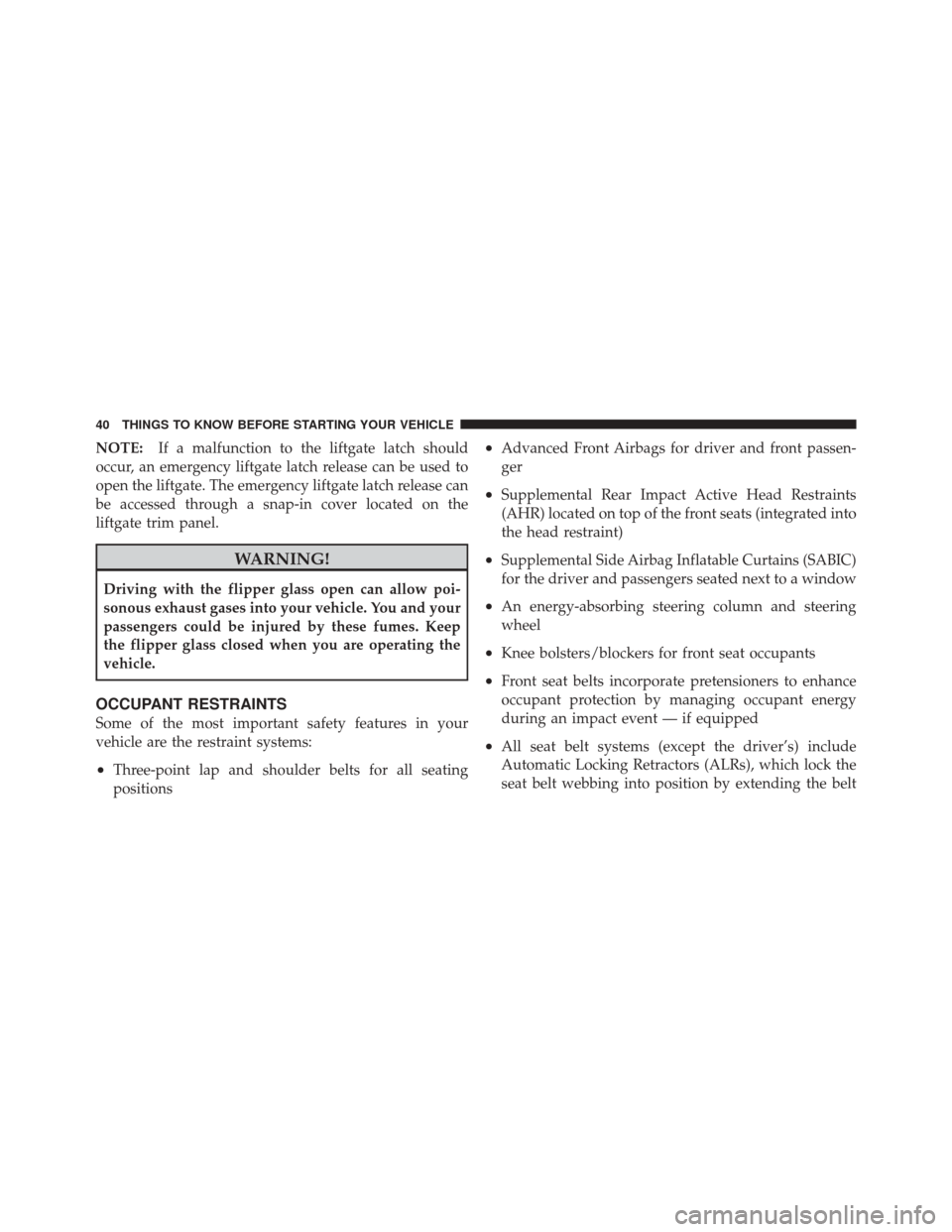
NOTE:If a malfunction to the liftgate latch should
occur, an emergency liftgate latch release can be used to
open the liftgate. The emergency liftgate latch release can
be accessed through a snap-in cover located on the
liftgate trim panel.
WARNING!
Driving with the flipper glass open can allow poi-
sonous exhaust gases into your vehicle. You and your
passengers could be injured by these fumes. Keep
the flipper glass closed when you are operating the
vehicle.
OCCUPANT RESTRAINTS
Some of the most important safety features in your
vehicle are the restraint systems:
•Three-point lap and shoulder belts for all seating
positions
•Advanced Front Airbags for driver and front passen-
ger
•Supplemental Rear Impact Active Head Restraints
(AHR) located on top of the front seats (integrated into
the head restraint)
•Supplemental Side Airbag Inflatable Curtains (SABIC)
for the driver and passengers seated next to a window
•An energy-absorbing steering column and steering
wheel
•Knee bolsters/blockers for front seat occupants
•Front seat belts incorporate pretensioners to enhance
occupant protection by managing occupant energy
during an impact event — if equipped
•All seat belt systems (except the driver’s) include
Automatic Locking Retractors (ALRs), which lock the
seat belt webbing into position by extending the belt
40 THINGS TO KNOW BEFORE STARTING YOUR VEHICLE
Page 42 of 522
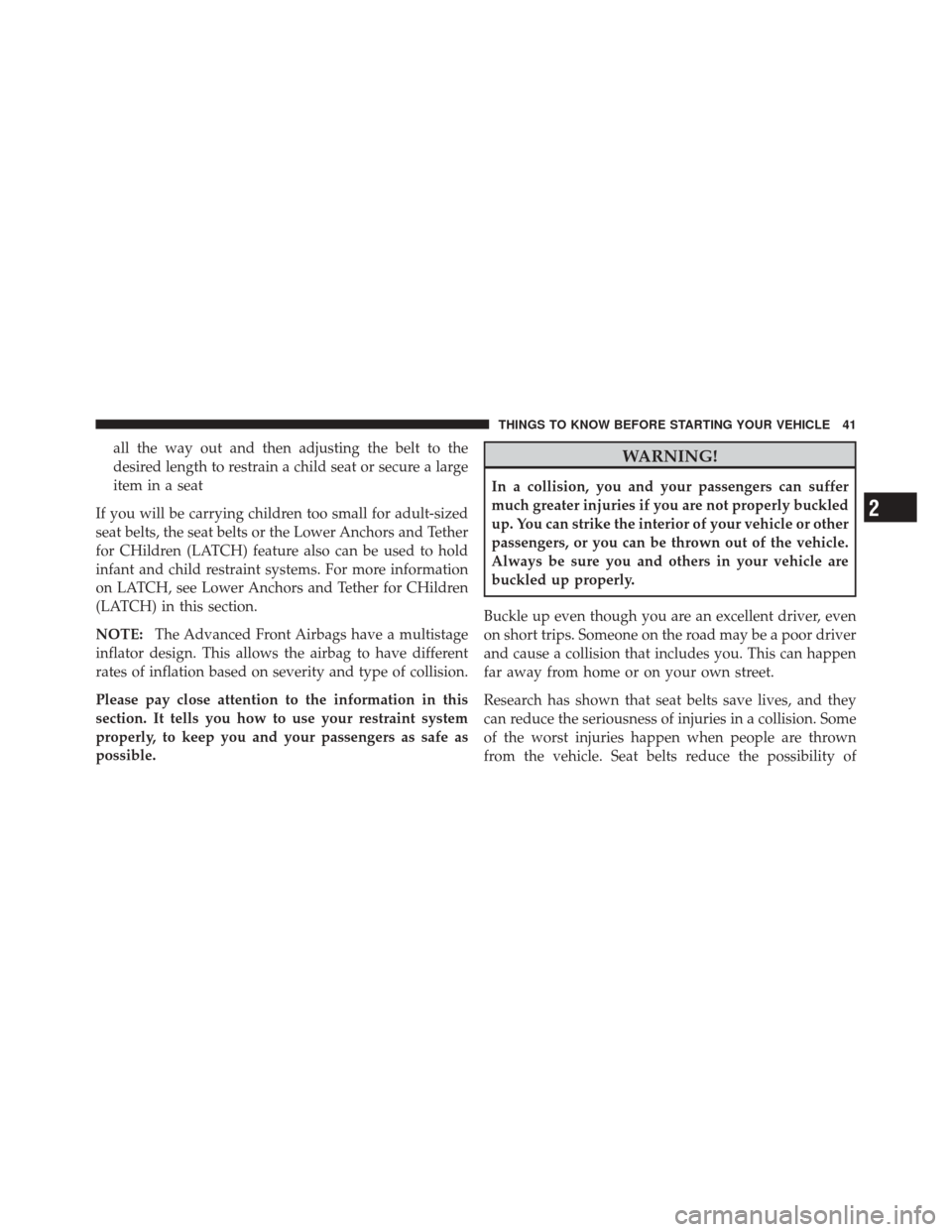
all the way out and then adjusting the belt to the
desired length to restrain a child seat or secure a large
item in a seat
If you will be carrying children too small for adult-sized
seat belts, the seat belts or the Lower Anchors and Tether
for CHildren (LATCH) feature also can be used to hold
infant and child restraint systems. For more information
on LATCH, see Lower Anchors and Tether for CHildren
(LATCH) in this section.
NOTE: The Advanced Front Airbags have a multistage
inflator design. This allows the airbag to have different
rates of inflation based on severity and type of collision.
Please pay close attention to the information in this
section. It tells you how to use your restraint system
properly, to keep you and your passengers as safe as
possible.WARNING!
In a collision, you and your passengers can suffer
much greater injuries if you are not properly buckled
up. You can strike the interior of your vehicle or other
passengers, or you can be thrown out of the vehicle.
Always be sure you and others in your vehicle are
buckled up properly.
Buckle up even though you are an excellent driver, even
on short trips. Someone on the road may be a poor driver
and cause a collision that includes you. This can happen
far away from home or on your own street.
Research has shown that seat belts save lives, and they
can reduce the seriousness of injuries in a collision. Some
of the worst injuries happen when people are thrown
from the vehicle. Seat belts reduce the possibility of
2
THINGS TO KNOW BEFORE STARTING YOUR VEHICLE 41
Page 48 of 522
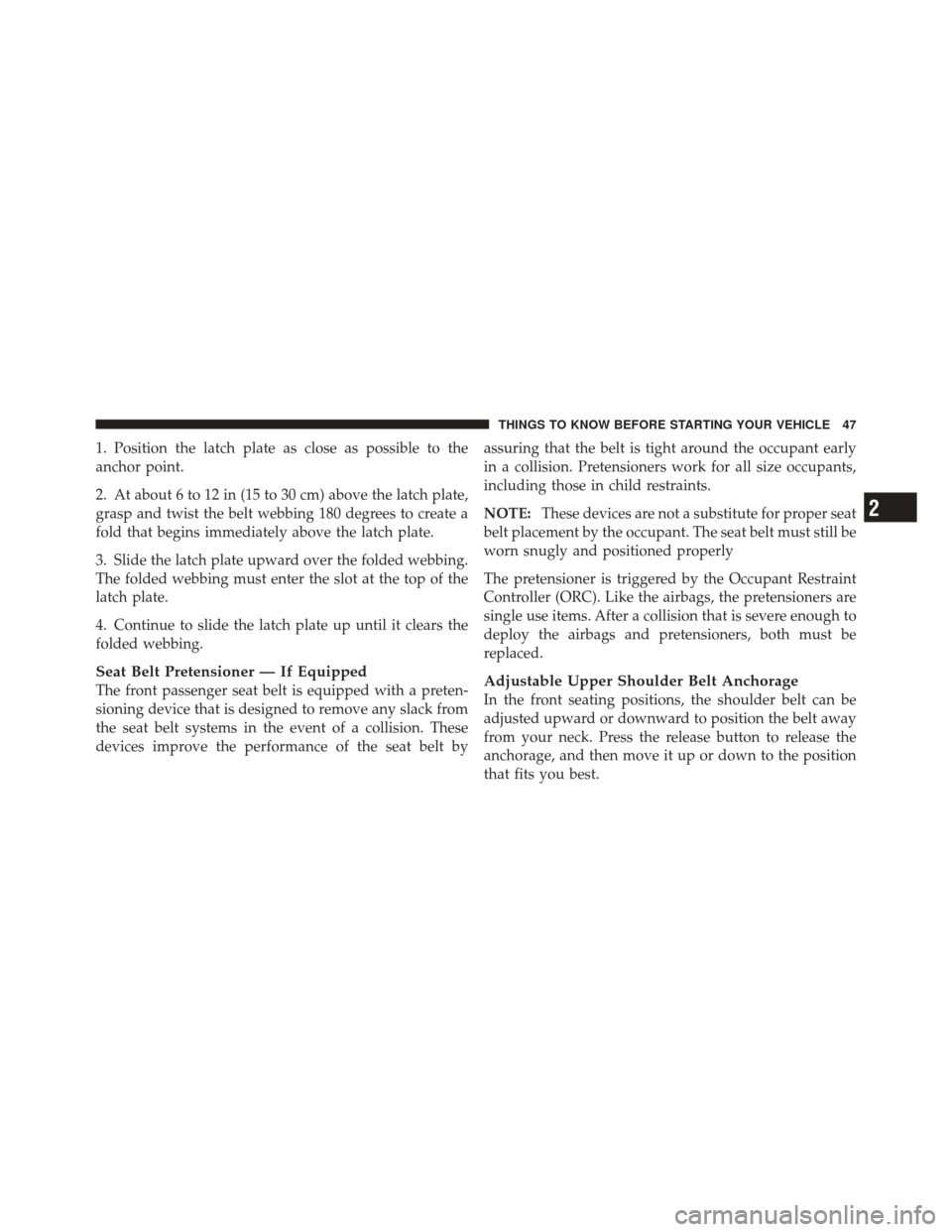
1. Position the latch plate as close as possible to the
anchor point.
2. At about 6 to 12 in (15 to 30 cm) above the latch plate,
grasp and twist the belt webbing 180 degrees to create a
fold that begins immediately above the latch plate.
3. Slide the latch plate upward over the folded webbing.
The folded webbing must enter the slot at the top of the
latch plate.
4. Continue to slide the latch plate up until it clears the
folded webbing.
Seat Belt Pretensioner — If Equipped
The front passenger seat belt is equipped with a preten-
sioning device that is designed to remove any slack from
the seat belt systems in the event of a collision. These
devices improve the performance of the seat belt byassuring that the belt is tight around the occupant early
in a collision. Pretensioners work for all size occupants,
including those in child restraints.
NOTE:
These devices are not a substitute for proper seat
belt placement by the occupant. The seat belt must still be
worn snugly and positioned properly
The pretensioner is triggered by the Occupant Restraint
Controller (ORC). Like the airbags, the pretensioners are
single use items. After a collision that is severe enough to
deploy the airbags and pretensioners, both must be
replaced.Adjustable Upper Shoulder Belt Anchorage
In the front seating positions, the shoulder belt can be
adjusted upward or downward to position the belt away
from your neck. Press the release button to release the
anchorage, and then move it up or down to the position
that fits you best.
2
THINGS TO KNOW BEFORE STARTING YOUR VEHICLE 47
Page 50 of 522
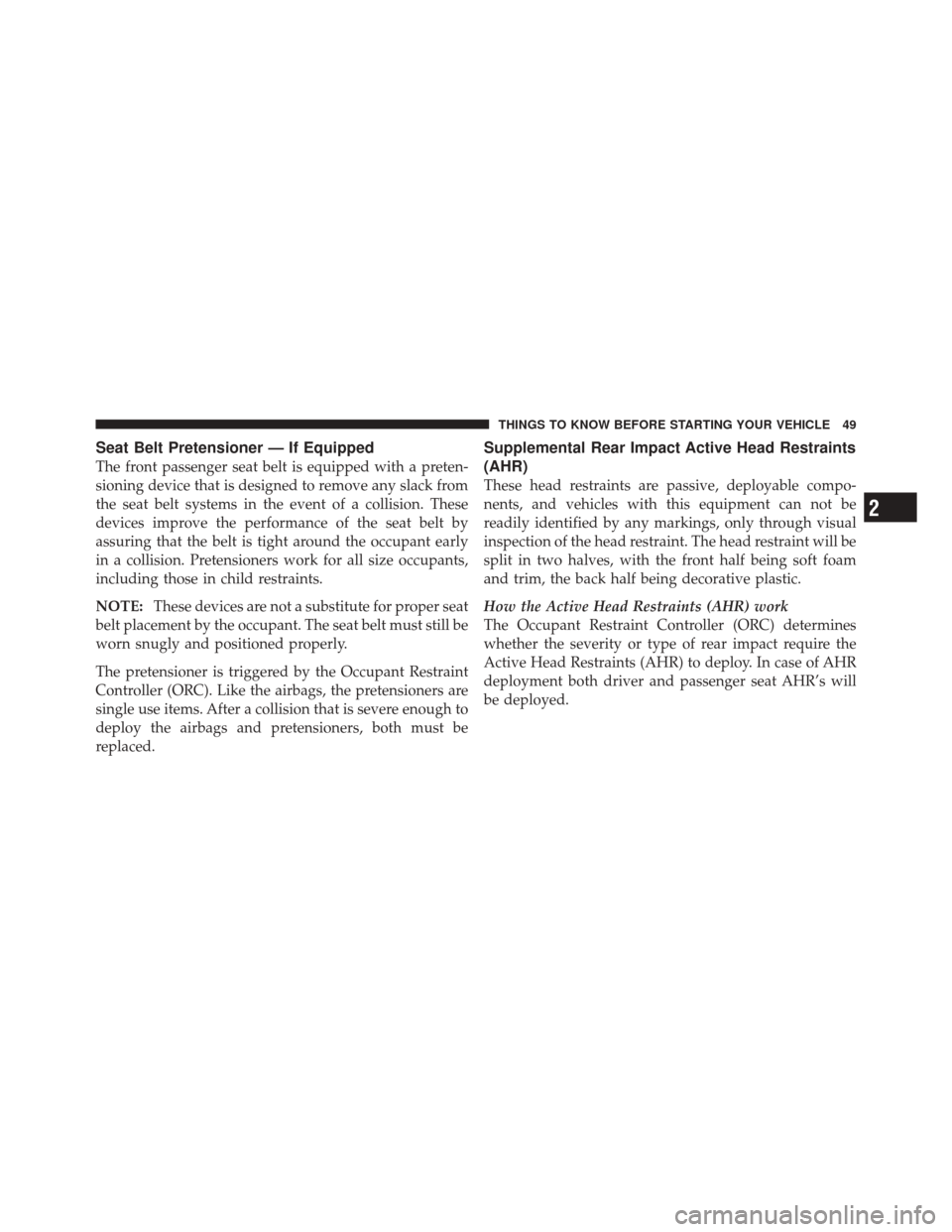
Seat Belt Pretensioner — If Equipped
The front passenger seat belt is equipped with a preten-
sioning device that is designed to remove any slack from
the seat belt systems in the event of a collision. These
devices improve the performance of the seat belt by
assuring that the belt is tight around the occupant early
in a collision. Pretensioners work for all size occupants,
including those in child restraints.
NOTE:These devices are not a substitute for proper seat
belt placement by the occupant. The seat belt must still be
worn snugly and positioned properly.
The pretensioner is triggered by the Occupant Restraint
Controller (ORC). Like the airbags, the pretensioners are
single use items. After a collision that is severe enough to
deploy the airbags and pretensioners, both must be
replaced.
Supplemental Rear Impact Active Head Restraints
(AHR)
These head restraints are passive, deployable compo-
nents, and vehicles with this equipment can not be
readily identified by any markings, only through visual
inspection of the head restraint. The head restraint will be
split in two halves, with the front half being soft foam
and trim, the back half being decorative plastic.
How the Active Head Restraints (AHR) work
The Occupant Restraint Controller (ORC) determines
whether the severity or type of rear impact require the
Active Head Restraints (AHR) to deploy. In case of AHR
deployment both driver and passenger seat AHR’s will
be deployed.
2
THINGS TO KNOW BEFORE STARTING YOUR VEHICLE 49
Page 57 of 522
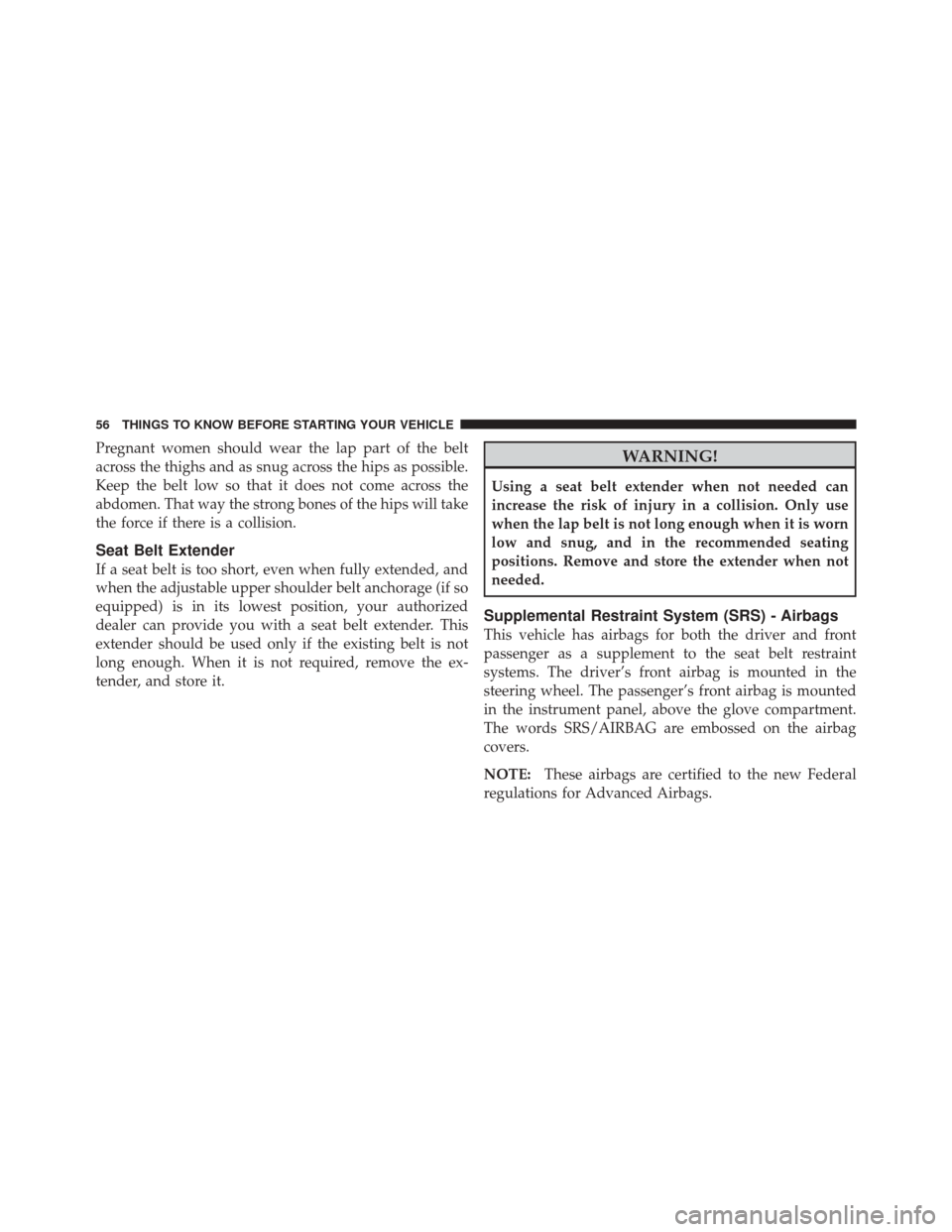
Pregnant women should wear the lap part of the belt
across the thighs and as snug across the hips as possible.
Keep the belt low so that it does not come across the
abdomen. That way the strong bones of the hips will take
the force if there is a collision.
Seat Belt Extender
If a seat belt is too short, even when fully extended, and
when the adjustable upper shoulder belt anchorage (if so
equipped) is in its lowest position, your authorized
dealer can provide you with a seat belt extender. This
extender should be used only if the existing belt is not
long enough. When it is not required, remove the ex-
tender, and store it.
WARNING!
Using a seat belt extender when not needed can
increase the risk of injury in a collision. Only use
when the lap belt is not long enough when it is worn
low and snug, and in the recommended seating
positions. Remove and store the extender when not
needed.
Supplemental Restraint System (SRS) - Airbags
This vehicle has airbags for both the driver and front
passenger as a supplement to the seat belt restraint
systems. The driver’s front airbag is mounted in the
steering wheel. The passenger’s front airbag is mounted
in the instrument panel, above the glove compartment.
The words SRS/AIRBAG are embossed on the airbag
covers.
NOTE:These airbags are certified to the new Federal
regulations for Advanced Airbags.
56 THINGS TO KNOW BEFORE STARTING YOUR VEHICLE
Page 58 of 522
The Advanced Front Airbags have a multistage inflator
design. This allows the airbag to have different rates of
inflation that are based on the severity and type of
collision.This vehicle may also be equipped with Supplemental
Side Airbag Inflatable Curtains (SABIC) that run the
entire length of the headliner to protect the driver, front,
and rear passengers sitting next to a window.
1 — Driver Airbag
2 — Passenger Airbag
Supplemental Side Airbag Inflatable Curtains (SABIC)
Label Location
2
THINGS TO KNOW BEFORE STARTING YOUR VEHICLE 57
Page 59 of 522
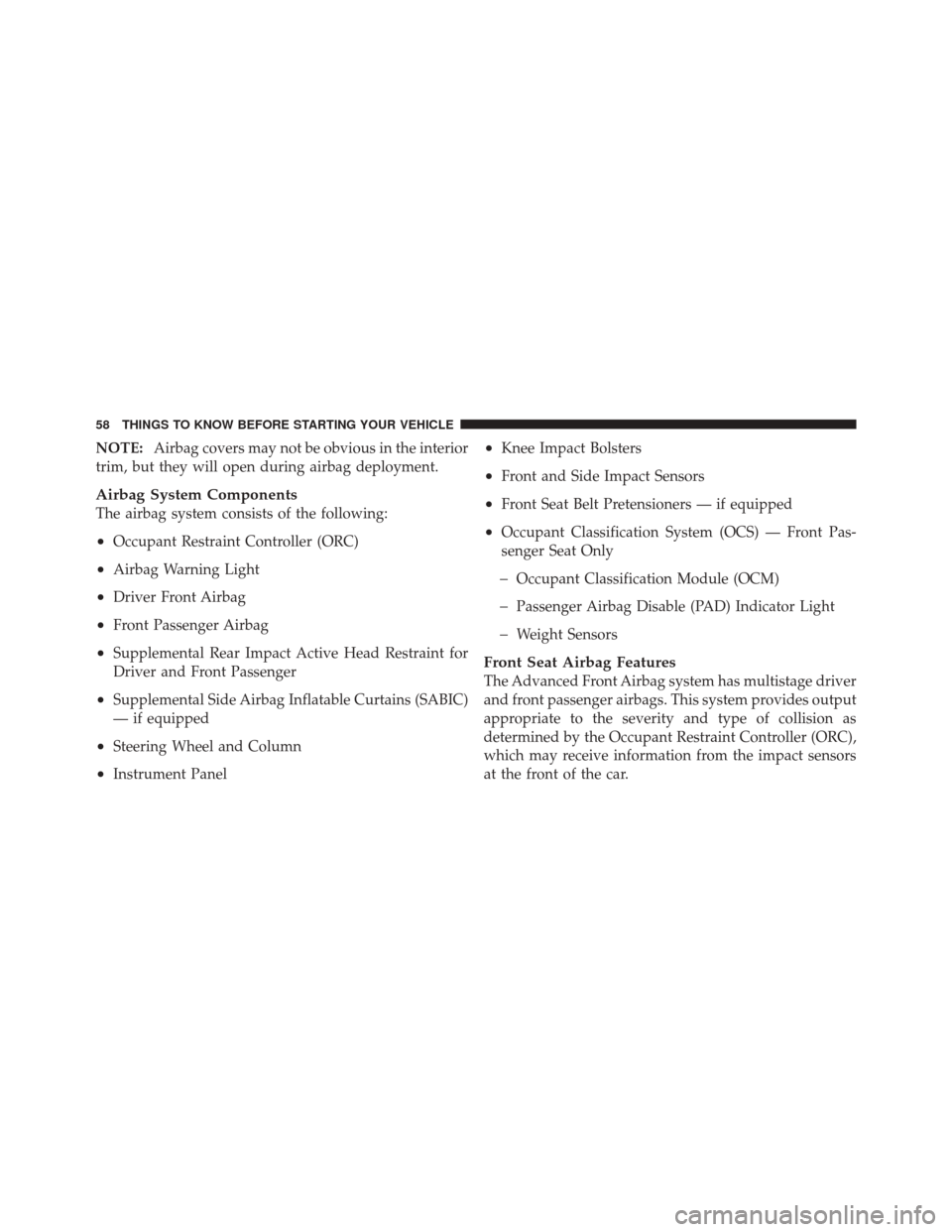
NOTE:Airbag covers may not be obvious in the interior
trim, but they will open during airbag deployment.
Airbag System Components
The airbag system consists of the following:
•Occupant Restraint Controller (ORC)
•Airbag Warning Light
•Driver Front Airbag
•Front Passenger Airbag
•Supplemental Rear Impact Active Head Restraint for
Driver and Front Passenger
•Supplemental Side Airbag Inflatable Curtains (SABIC)
— if equipped
•Steering Wheel and Column
•Instrument Panel
•Knee Impact Bolsters
•Front and Side Impact Sensors
•Front Seat Belt Pretensioners — if equipped
•Occupant Classification System (OCS) — Front Pas-
senger Seat Only
�Occupant Classification Module (OCM)
�Passenger Airbag Disable (PAD) Indicator Light
�Weight Sensors
Front Seat Airbag Features
The Advanced Front Airbag system has multistage driver
and front passenger airbags. This system provides output
appropriate to the severity and type of collision as
determined by the Occupant Restraint Controller (ORC),
which may receive information from the impact sensors
at the front of the car.
58 THINGS TO KNOW BEFORE STARTING YOUR VEHICLE